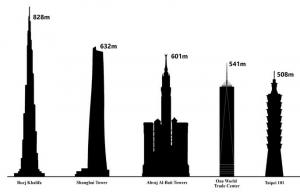La Sagrada Familia: analysis, meanings and history of the basilica
La Sagrada Familia is one of the most emblematic Catholic churches and is located in the city of Barcelona, Spain.
The temple was designed by Antonio Gaudí at the end of the 19th century. It belongs to the so-called modernism, a movement that received the name of Art Nouveau in France, Liberty in Italy, Jugendstil in Germany and Sezessionstil in Austria.

The Sagrada Familia has not yet finished construction, although it is possible that this generation can witness the final result. Apparently, the temple could be completed in the first third of the XXI century.
Although elements reminiscent of the Middle Ages can be distinguished, the building is not framed in the neo-gothic style that Gaudí once used, but represents a turning point in all his his work. Let's see why.
Analysis of the Sagrada Familia
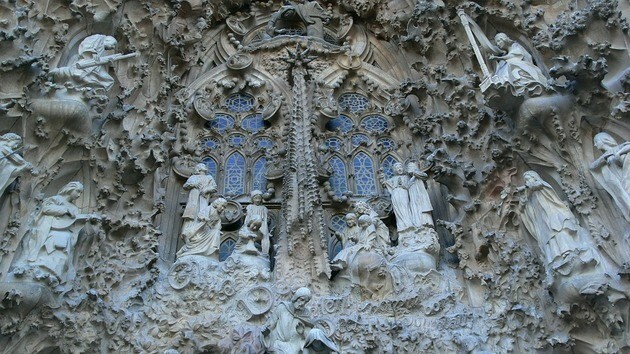
We can distinguish two levels of analysis when we speak of the Holy Family, one referring to its structural and aesthetic characteristics and the other referring to its function and meaning. Both levels intertwine and need each other. That was one of Gaudí's genius. The structure, therefore, is the resource that allows the architect to affirm his spiritual and aesthetic values.
The entire monument is designed from two fundamental axes that moved the architect: the Christian discourse and the observation of nature. For this reason, the basilica cannot be understood without attention to these two elements.
Gaudí uses symbols and allegories from the Bible and relates them structurally, formally and symbolically with nature. And the truth is that, for the architect, nature was the work of God.
Instead of making plans, Gaudí made three-dimensional models with which he directed the project. One of his techniques was to create volumes using a pendulum system. Once this was done, he placed a mirror below them and analyzed the inverted image that the reflection offered, which allowed him to conceive and visualize the structure of the building.
Structure
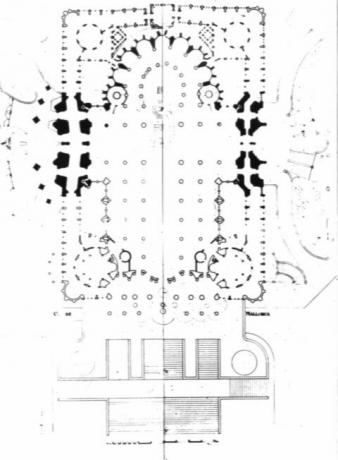
This church is built on a Latin cross plan, from which five naves are formed. On the crossing point of the plant, there is a semicircular apse that crowns the space.
It is designed to highlight three fundamental facades: the Nativity façade, the Passion façade and the Façade of the Glory, all of them conceived as large stone books that relate the so-called "history of the salvation".
In addition, Gaudí planned the construction of 18 towers. The highest will represent Jesus Christ, while the others will represent the apostles, evangelists and the Virgin Mary. The monument will thus reach a maximum height of 172.5 meters.
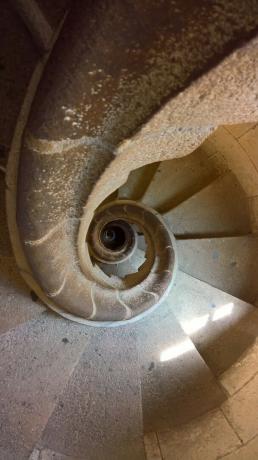
The organic appearance of the facades and the interior of the temple derives from the observation of the geometry of nature. It is not surprising that the columns resemble irregular tree trunks, branches, snails and many other elements.
The main constructive contribution of it is distinguished as the use of hyperboloid, paraboloid, helicoid, cone-shaped and ellipsoid structures.
According to experts, the architectural or structural solutions devised by Gaudí had never been implemented, so that the structure of the Sagrada Familia is also a construction thesis still in progress. growth.
The meanings
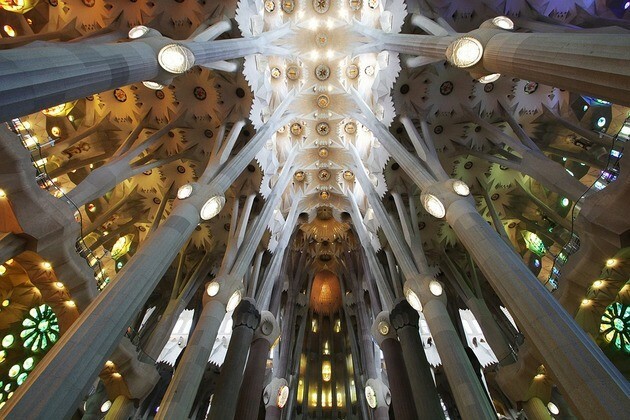
Light is an element of construction, but at the same time it is charged with meaning. This is much more evident in sacred art. Thus, Gaudí designed the lighting of the Sagrada Familia to deepen the spiritual allegories and not only to illuminate the space functionally.
The architect uses colorful stained glass windows that provide emotional effects, in this case following the inspiration of Gothic art that preferred colored screens to the use of diaphanous light.
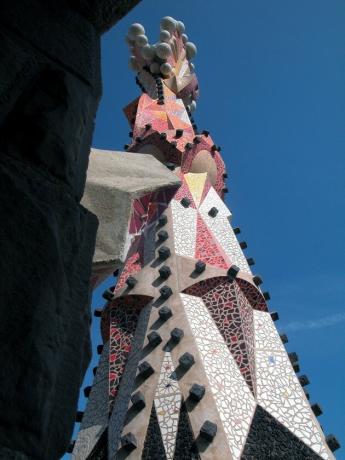
Thus, the facade of the Nativity receives the light of dawn as a symbol of the birth of Jesus, light of the world. The façade of the passion receives the light of the evening or the setting sun, a metaphor for the death of Jesus and his descent into hell. And the façade of the Glory receives broad daylight that illuminates the central nave in all its splendor, a symbol of the resurrection.
In addition to light, Gaudí uses color in the wall lights and details of the monument in a symbolic way. That is why you can see color in pinnacles and various decorative motifs, always allegorical in nature.
Temple history
Cultural historical context
In the 19th century, the arts and architecture were significantly affected by the industrialization that substituted artisanal processes and made products more economical through production in Serie.
By then, beauty was not a concern of the industrial sector, so many things began to become practical but not very aesthetic. Faced with this, the arts responded with different movements, some of which were anchored in artisanal processes or in historical revisionism, that is, in the attachment to the aesthetics and resources of the past.
Modernism, on the other hand, was a movement that sought to take advantage of the best resources of the industrialized era but in search of an aesthetic that represented its time. Therefore, many artists and architects began to explore with novel materials and techniques, seeking to recover the sense of taste and beauty. Sooner rather than later, personal styles were noticed.
The origin of the idea
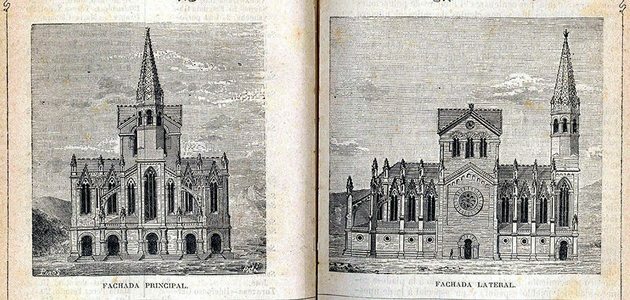
It was Josep María Bocabella who had the idea of making a temple dedicated to this devotion. Bocabella was a bookseller in the city linked to the Congregation of Sons of the Holy Family and the Congregation of Missionary Daughters of the Holy Family of Nazareth, founded by Josep Manyanet.
In order to raise the necessary funds, Bocabella founded the San José Spiritual Association of Devotees in 1866. Over the years, this made it possible for the land to be purchased in 1881.
Initially, Bocabella intended to make a replica of the Loreto sanctuary in Italy and commissioned the project to the architect Francisco de Paula del Villar Lozano, who put that idea aside and preferred a concept neo-gothic.
The first stone of the Sagrada Familia was laid in 1882 under the direction of Villar, a ceremony that was attended by the young Antonio Gaudí, assistant to the architect Joan Martorell. Martorell, in fact, served as Bocabella's advisor.
In 1883, the construction of the temple began, but in that same year Villar resigned after irreconcilable differences with Bocabella. The latter asked Martorell to take over, but the architect refused and recommended his assistant, Antonio Gaudí. From then on, everything would take an unexpected turn.
See also Eiffel Tower
Gaudí's entrance to the project
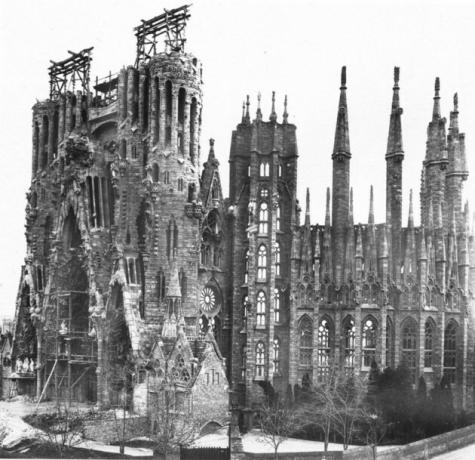
With some of the construction advanced, Gaudí overturned the Villar concept and transformed this project, his first major project, into a novel organic architectural development. Knowing that the Sagrada Familia would take generations, Gaudí made scale models to serve as models.
Gaudí accompanied the construction of the temple until his death, which occurred in 1926 as a result of an unfortunate run-over.
The work continued, but in 1936, after the uprising that would cause the Spanish Civil War, a Attack carried out by the anarchists against the project destroyed the models, photographs and models. This destruction meant invaluable delays in construction.
The architect Lluís Bonet i Garí managed to recover some vestiges and preserve them. Of what little was left, the architects Francesc Quintana and Isidre Puig i Boada joined Bonet and together they rebuilt just the model of the main nave.
The complexity of the project devised by Gaudí and the absence of documentary sources have delayed the project much longer than imagined.
7 curious facts about the Sagrada Familia

1) After the arson caused by the anarchists in 1936, the caretakers of the temple decided to wall up what was left in plaster to protect the heritage from other possible attacks. When the danger passed, the sandwich was removed.
2) An article published by the BBC includes the testimony of the architect Jordi Faulí i Oller, who is currently responsible for the Sagrada Familia. According to Faulí, Gaudí's genius was such that:
The columns, for example, no one had made them in the history of architecture. Columns that are transformed from the base to the top where it almost looks like a circle. They are fine-tuned until they reach heaven. He is the search for perfection, the search for God.
3) Because the solutions devised by Gaudí had never been used in architecture, today it is It is necessary to use different computer programs to find the architectural formulas of this genius.
4) 28 artists have participated in the development of the sculptural program of the porticoes or facades over the years, including who stand out the artists Llorenç and Joan Matamala, Jaume Busquets, Carles Mani, Joaquim Ros i Bofarull, Etsuro Sotoo and Josep Maria Subirachs.
5) The facade of the Nativity and the crypt of the expiatory temple La Sagrada Familia were named a World Heritage Site in 2005. They thus join the works of Gaudí that since 1984 have been on the Unesco World Heritage list. In this regard, Unesco informs through its website that the works:
... testify to the exceptional contribution of Gaudí's creations to the evolution of architecture and construction techniques in the late 19th and early 20th centuries. They are the expression of an eclectic and highly personal style that its author unleashed not only in architecture, but also in gardening, sculpture and many other decorative arts. The seven buildings are: Park Güell, Güell Palace, Casa Milá, Casa Vicens, Gaudí's work in the facade of the Nativity and the crypt of the Sagrada Familia, the Casa Batlló and the crypt of the Colony Güell.
6) They are called "expiatory temples" to those temples that permanently expose the Blessed Sacrament for the forgiveness of sins.
7) The Expiatory Church of the Holy Family is expected to be completed in 2026.
It may interest you: Art nouveau (modernist art)


